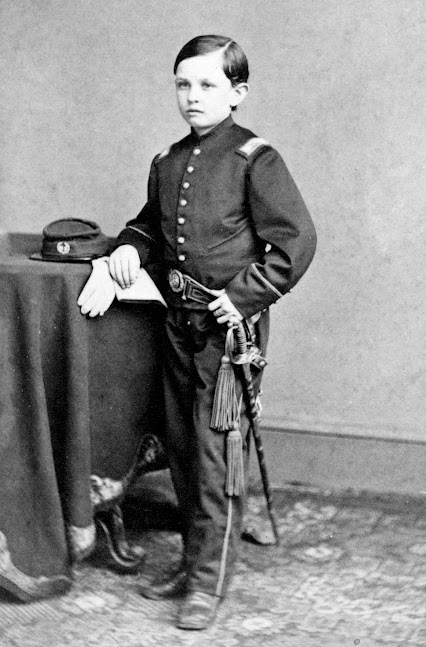The East Room in the Executive Mansion became known for events, parties, funerals, and other large-scale events. The room is the largest in the White House, and it was one of the last rooms to be finished and decorated.
 |
| First Lady, Mary Todd Lincoln. A Mathew Brady photograph, 1861. |
On April 18, 1861, about 60 militiamen from Kansas took up temporary residence in the East Room, pending barracks' construction in the city. They did serious damage to the carpet and sometimes shot bullets into the walls.
Mrs. Lincoln immediately got into the East Room for redecoration once the soldiers moved out in 1861. The East Room had undergone extensive renovations during President Buchanan’s term in office, but Mary wanted to fix and rebuild the East Room. Unfortunately, this wasn’t met entirely with praise. Some critics accused Mary of spending money frivolously during warfare and thought she should be more focused on helping the war efforts rather than decorating. Republican Senator Benjamin Wade supposedly responded to a White House invitation with “Are President and Mrs. Lincoln aware that there is a civil war?” Yet, it can be argued that keeping the White House in the state it had been would have gotten her just as much criticism.
Mary’s redecoration of the East Room was an expensive venture. Mary hired John Alexander to be her contractor and had a budget of $20,000 ($620,500 today) that she exhausted quite quickly.
Mary bought wallpaper in a heavy patterned velvet cloth paper from Paris in crimson, garnet, and gold and supplied by William H. Carryl & Brother of Philadelphia won lavish praise from the New York Herald. The floor covering was an Axminster carpet woven in Glasgow, Scotland. The largest loom in the world was needed to weave the carpet, which covered the entire floor. The drapes were crimson with heavy gold fringe and numerous gold tassels, while the lace curtains behind them were imported from Switzerland. Later that year, a new blue-green carpet from Brussels was covered with fruits and flowers that cost $2,500 ($77,600 today). However, the carpeting was described by an observer as “pale sea green, and in effect looked as if the ocean, in gleaming and transparent waves, were tossing roses at your feet.”
Mary had the three Jacksonian-era chandeliers reinstalled after they were meticulously cleaned. They were so brilliant that the press assumed they were new. Below each chandelier, Mrs. Lincoln left the three large mahogany tables with black and gold marble inlays, which had long occupied the room, below each chandelier.
The East Room under the Lincolns remained sparsely furnished. However, it befits a reception hall.
In December 1861, a levee was held to celebrate the year of redecoration in the East Room, and it was met with mixed responses. Just as when Mrs. Lincoln started her redecoration initiative, there were plenty of critics and those who were pleased with the update to the Executive Mansion, and a large party was held to celebrate the completion of the refurbishing.
In February 1862, the First Lady scandalized the North by throwing an elaborate
White House party, inaccurately called a Ball (there was no dancing because Lincoln
emphatically forbade it). Instead of the traditional open house, she decided to invite a
select group, thereby antagonizing those who were excluded. It was widely viewed as a
regrettable social blunder
At the time of Lincoln's death in 1865, the East Room contained 24 chairs, four sofas, four tables, eight sets of drapes, eight sets of lace curtains, eight mirrors, and one carpet. All the furniture was in poor shape. During his administration, members of the public attending the weekly receptions in the room had heavily vandalized the room in seeking souvenirs, ripping down portions of the wallpaper, and stealing cords and tassels from the drapes. Someone even cut a square yard from one of the damask drapes. Others took scissors and knives to the carpet, gouging the oak floor beneath, and gilded ornaments were stolen from the mantels.
NOTE: Two funerals for Lincoln Family members were held in the East Room in the 1860s. The first was that of 11-year-old William "Willie" Wallace Lincoln, Abraham and Mary's third child, who died of typhoid fever on February 21, 1862. Just over three years later, President Lincoln's body lay in state in the East Room as well, and his funeral was held there on April 19, 1865.
 |
| Lincoln Funeral in the East Room (Harper's Weekly, May 6, 1865) |
President Andrew Johnson (April 15, 1865 - March 4, 1869) had the White House public rooms on the State Floor refurbished in 1866. His wife, Eliza McCardle Johnson, was in frail health and did little entertaining or overseeing the White House. Johnson instead relied on his daughter, Martha Patterson, the wife of Senator David T. Patterson. In May, the East Room was cleared of furnishings. Mrs. Patterson oversaw the selection of new yellow wallpaper with a black and gold border, lace curtains, and reupholstered furniture. The ceiling was repainted, and frescoes added, and the ceiling centerpieces and cornices were regilded. Only once did Mrs. Johnson intervene, and that was to request that the paint applied to the ceiling be of the highest quality. Patterson also had the three large marble-topped tables removed from the East Room and placed in the family private quarters and two of the four pier tables added to the Family Dining Room. The East Room was finished in early 1867.
 |
| The East Room in a stereograph photograph made during the administration of President Andrew Johnson, showing the Lincoln redecorations. |
Compiled by Dr. Neil Gale, Ph.D















